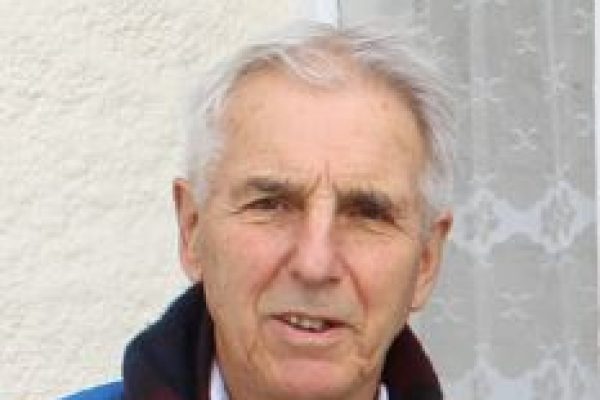WHEN the population of West Falkland Islands had little else to talk about the conversation would invariably turn to the mysterious disappearance of Edward Casey, who was known generally as Ned. In late June 1890 a resident of Saunders Island fell ill and Ned was requested by the Manager of the Island, which ran several thousand sheep and which lies off the north west coast of West Falklands, to take a dingy and row across to the mainland of Hill Cove and make the relatively short 20 minutes walk to Shallow Bay house where a shepherd William Atkins lived.
Most likely Casey would needed to have borrowed a horse and ridden for 5-6 hours to Fox Bay where a doctor normally resided. The first telephone line on West Falklands was not introduced until 1917 when William Luxton of Chartres sheep farm installed a line between his farm and Fox Bay with an ‘exchange’ at Goring House. Casey was expected to return to Saunders Island accompanied by a doctor. He was an experienced oarsman and sailor having worked on the cutter Foam (65 tons) which in 1863 had been bought by the Crown Agents of London for the Government of the Falklands for the prime purpose of carrying mail and passengers between the Islands and Montevideo in Uruguay.
In 1873 the vessel was sold to Andreaz Pitaluga of Salvador who in turn had sold the Foam to Captain Charles Hansen of Carcass Island. But on 04th May 1890 a severe South West gale resulted in the cutter being driven ashore before eventually breaking-up.
It would appear that Ned Casey had then sought employment on Saunders Island. While crossing Reef Channel in the dingy it was known that Ned had boarded the wind-bound schooner Hornet, which lay at anchor, to exchange greetings with the crew – and that was the last occasion that he was seen alive. But for sure he did make it to the mainland. After several days had elapsed and Ned had not returned to the Island with a doctor as anticipated, another employee was sent across to the mainland to check his whereabouts. When this man arrived at the recognized landing area at Shallow Bay he discovered Ned’s dingy hauled-up on the beach above the high water mark and rather strangely his coat was tidily rolled-up inside the dingy but there was no sign of Ned. It was supposed that he might have fallen over the cliffs in darkness but there was no sign of his body. It had also been noted that dense fog had engulfed the west coast of Hill Cove sheep farm on that particular afternoon. Contact was made between Shallow Bay and Hill Cove settlement and a search party was hastily organized and the Hill Cove farm manager Mr. Sydney Miller Snr. who was the son-in-law of Captain Charles Hansen, and who had only just been appointed Manager of the farm in 1889, readily made horses and men available and with the assistance of a contingent from Saunders Island a thorough search was conducted for more than a week but there was no sign of Ned Casey. Mr. Miller’s son, also named Sydney and the youngest of 4 children, later managed Hill Cove from 1928-1932 before resigning to become Manager of Roy Cove in 1932 where he remained until his retirement 38 years later in 1970.
It would not be until 23 years later that the mystery surrounding the disappearance of Ned Casey would finally be solved. On 30th November 1913 a Hill Cove shepherd Edward Johnson, who lived at Shallow Bay, was looking for stray sheep at a notoriously isolated, dangerous and rocky coastal area of Hill Cove farm named Trap/Darry (Doree) Valley. This treacherous area was accessible only by foot and as the shepherd walked between the stone-runs and rocks he discovered the remains of Ned Casey lying face down with his arms folded beneath his body. He was identifiable by a ragged portion of his Cardigan jacket and a piece of his trousers, plus boots and leggings. By his side lay a sheath knife bearing the initials of Donald McInnes who formerly worked at the neighbouring farm of Roy Cove.
Legend has it that Edward Johnson carefully stored the remains of the body in a sack and took them into Hill Cove settlement, only to be firmly told to return the bones to the location where they found in Darry Valley. This command he duly carried out. In December 1913 Sydney Miller wrote to John Quayle Dickson, who was the Falklands Colonial Secretary based in Stanley, to official notify him of the discovery and suggesting that if he required further information about the disappearance of Casey in 1890 then he should contact William Atkins who by now had become the Chief Constable in the Falklands. It seems almost certain that Ned Casey had become disorientated in the dense fog which had settled along the north west coast on that fateful winter’s day in 1890 and he had walked to the south as opposed to south west. Somewhat surprisingly an inquest into his death appears never to have been convened and consequently no death certificate issued and he did not receive a Christian burial. However recently revealed documents, never previously published, severely question the integrity of the ill-fated Ned Casey. This assumption has arisen through letters that were originally preserved and then discovered by descendants of Captain Charles Hansen, in which it is clearly stated that a fraudulent cheque for the sum of 105 pounds (equivalent to 2 years wages) was found in a pocket of the coat that Casey had surprisingly left under the dingy. It will be remembered that Casey was previously employed by Captain Hansen as a seaman on the wrecked ship Foam before he sought employment on Saunders Island. In a hand written letter dated 24th September 1890 to Dr. J.A. Going at Fox Bay, who in addition to his medical duties also served as the West Falklands Magistrate, Captain Hansen wrote as follows: ‘I have to thank you exceedingly for the information respecting the cheque for 105 pounds – found in the late Casey’s coat pocket. I was able to write at once about it to prove it was an undoubted forgery. He must have extracted the blank cheque from my dining room table, I having to leave him alone for a few seconds when settling his accounts. Yours Truly, Charles Hansen’. Sadly, Captain Hansen would meet his death just about one year later when on 4th October 1891 he was accidently drowned at sea while crossing from Santa Cruz (Argentina) to Carcass Island in the ship Result of which he was the captain. The weather was fine with a high sea running and he was standing at the bow, and in the act of taking a bearing by the sun, when the vessel suddenly lurched and he fell overboard. He swam for around 5 minutes but the weight of his clothes was thought to have dragged him down before a boat could reach his position in the water. The F.I. Magazine, in reporting the incident, said: ‘We have lost a much respected citizen’. As for the bones of Edward ‘Ned’ Casey which were taken back to where they found in Trap/Darry Valley in 1913? They remain there to this day and can be found surrounded by a circle of rocks on the side of a ridge known as Casey’s Hill. There is no other form of identification.
Acknowledgments: J.C.N.A. Mrs. Sally Blake, Mr. Ian Hansen.















